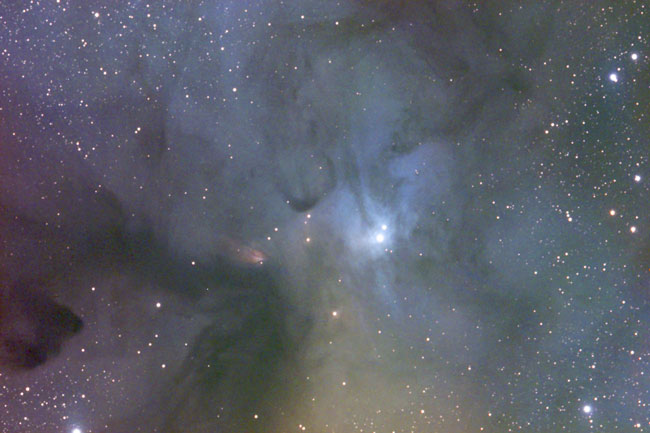Credit & Copyright: Gary Stevens
Explanation:
Why does this starfield photograph resemble an
impressionistic painting?
The effect is created not by
digital trickery but by large amounts of
interstellar dust.
Dust, minute globs rich in
carbon and similar in
size to
cigarette smoke, frequently starts in the
outer atmospheres of large, cool, young stars.
The dust is dispersed as the star dies and grows
as things stick to it in the
interstellar medium.
Dense dust clouds are
opaque to
visible light and can completely hide background stars.
For less dense clouds, the capacity of dust to
preferentially reflect blue starlight becomes important,
effectively blooming the stars blue light out and
marking the surrounding dust.
Nebular gas emissions, typically brightest in
red light,
can combine to form areas seemingly created on an artist's canvas.
Photographed above is roughly one square degree of the nebula
IC 4603 near the bright star
Antares toward the
constellation of
Ophiuchus.
1999 2000 2001 2002 2003 2004 2005 2006 2007 2008 2009 2010 2011 2012 2013 2014 2015 2016 2017 2018 2019 2020 2021 2022 2023 2024 2025 |
Yanvar' Fevral' Mart Aprel' Mai Iyun' Iyul' Avgust Sentyabr' Oktyabr' Noyabr' Dekabr' |
NASA Web Site Statements, Warnings, and Disclaimers
NASA Official: Jay Norris. Specific rights apply.
A service of: LHEA at NASA / GSFC
& Michigan Tech. U.
|
Publikacii s klyuchevymi slovami:
IC 4603 - Ophiuchus - reflection nebula - Zmeenosec - otrazhatel'nye tumannosti
Publikacii so slovami: IC 4603 - Ophiuchus - reflection nebula - Zmeenosec - otrazhatel'nye tumannosti | |
Sm. takzhe:
Vse publikacii na tu zhe temu >> | |
